A municipality’s master plan is intended to set the vision and start the process of crafting the future of the municipality in regard to several elements, housing, history, culture, open space, transportation, finance, etc. Arlington began a very public discussion about these issues and the development of the Master Plan in 2012. In 2015, after thorough community wide discussion, the Master Plan was adopted by Town Meeting. This year, 2019, the focus is on passing Articles that will amend the current zoning bylaws in order to implement the housing vision that was approved in 2015.
Related articles
During the last few months, Arlington’s Department of Planning and Community Development and Zoning Bylaw Working Group have been conducting a study of the town’s industrial districts. The general idea has been to begin with an assessment of current conditions, and consider whether there are zoning changes that might make these districts more beneficial to the community as a whole.
To date, the major work products of this effort have been:
- A study of existing conditions, market analysis, and fiscal impact. Among other things, this slide deck will show you exactly where Arlington’s industrial districts are located.
- A set of test build scenarios.
- An initial set of zoning recommendations. These are high level ideas; they’d need further refinement to fit into the context of our zoning bylaws.
- A survey, to gather public input on several of the high-level recommendations.
The survey recently closed. I asked the planning department for a copy of they survey data, which they were generous enough to provide. That data is the subject of this blog post.
The survey generally consisted of pairs of questions: a yes/no or multiple choice, coupled with space for free-form comments. I’ll provide the yes/no and multiple choice questions (and answers!) here. Those interested in free-form commentary can find that in the spreadsheet linked at the bottom of this article.
208 people responded to the survey.
Industrial Zoning questions
(1) Which of the following uses would you support in the Industrial Districts? (check all that apply) (208 respondents)
| Industrial | 62.02% |
| Office | 76.92% |
| Breweries, Distilleries, and Wineries | 86.06% |
| Mixed Use (Office and Industrial Only) | 67.31% |
| Food Production Facilities | 55.77% |
| Flexible Office/Industrial Buildings | 68.27% |
| Coworking Space | 68.75% |
| Maker Space | 63.46% |
| Vertical Farming | 65.38% |
| Work Only Artist Studio | 63.94% |
| Residential | 42.79% |
| Other (please specify) | 12.02% |
(2) Would you support a waiver of the current 39-foot height maximum to allow heights up to 52 feet if the Applicant had to meet other site design, parking, or environmental standards? (207 respondents)
| Yes | 74.40% |
| No | 22.22% |
(3) Would you support a small reduction in the amount of required parking by development as an incentive to provide more bike parking given the districts’ proximity to the Minuteman Bikeway? (208 respondents)
| Yes | 68.27% |
| No | 30.77% |
(4) Would you support a variable front setback of no less than 6 feet and no more than 10 feet to bring buildings closer to the sidewalk and create a more active pedestrian environment? (207 respondents)
| Yes | 66.18% |
| No | 28.50% |
(5) Would you support zoning changes that require new buildings in the district to have more windows and greater building transparency, as well as more pedestrian amenities such as lighting, landscaping, art, or seating? (207 respondents)
| Yes | 81.64% |
| No | 13.53% |
Demographic questions
(7) Do you….(check all that apply) (206 respondents)
| live in Arlington | 99.51% |
| work in Arlington | 23.79% |
| own a business in Arlington | 9.71% |
| work at a business in one of Arlington’s industrial districts | 1.46% |
| own a business in one of Arlington’s industrial districts | 1.46% |
| patron of Arlington retail and restaurants | 76.70% |
| elected official in Arlington | 6.80% |
(8) What neighborhood do you live in? (207 respondents)
| Arlington Heights | 30.43% |
| Little Scotland | 2.42% |
| Poet’s Corner | 0.97% |
| Robbins Farm | 5.80% |
| Turkey Hill/ Mount Gilboa | 11.11% |
| Morningside | 4.35% |
| Arlington Center | 10.14% |
| Jason Heights | 8.21% |
| East Arlington | 20.77% |
| Kelwyn Manor | 0.00% |
| Not Applicable | 0.48% |
(9) How long have you lived in Arlington? (207 respondents)
| Under 5 years | 19.32% |
| 5 to 10 years | 15.46% |
| 10 to 20 years | 19.81% |
| Over 20 years | 45.41% |
According to US Census data [1], 72% of Arlington’s residents moved to Arlington since the beginning of the 2000’s (i.e., 20 years ago or less). The largest group responding to this survey has lived here 20+ years, implying that the results may be more reflective of long-term residents opinions.
(10) Please select your age group (199 respondents)
| Under 18 | 0.00% |
| 18-25 | 1.01% |
| 26-35 | 13.57% |
| 36-45 | 22.11% |
| 46-55 | 25.13% |
| 56-65 | 20.60% |
| 66-80 | 16.58% |
| 80+ | 1.01% |
(11) What is your annual household income? (188 respondents)
| $0-$19,999 | 1.06% |
| $20,000-$39,999 | 1.60% |
| $40,000-$59,999 | 5.32% |
| $60,000-$79,999 | 9.04% |
| $80,000-$99,999 | 4.79% |
| $100,000-$149,999 | 23.94% |
| $150,000-$200,000 | 17.55% |
| More than $200,000 | 36.70% |
Full Survey Results
As noted earlier, the survey provided ample opportunity for free-form comments, which are included in the spreadsheet below. There were a number of really thoughtful ideas, so these are worth a look.
Arlington Industrial District Survey
Footnotes
[1] https://censusreporter.org/profiles/16000US2501640-arlington-ma/, retrieved August 10th, 2020
It’s New Year’s eve and I’m determined to get my third and final “Arlington 2020” article written and posted before 2021 rolls in. I’ve written these articles to paint a picture of Arlington’s housing stock, and how our housing costs have changed over time. The first article looked at the number of one-, two-, and three-family homes and condominiums in Arlington. The second article looked at how the costs of these homes has varied over time.
In this article, I’m going to look at the per-unit costs for our different housing types. The per-unit cost is just the assessed value, divided by the number of units. For condos and single-family homes, the unit cost is simply the assessed value. For two-family homes, it’s the assessed value divided by two. For a ten-unit apartment building, it’s the assessed value divided by ten. We’ll look at the price ranges within housing types, as well as the general differences between them.
The information here doesn’t include residential units from Arlington’s 76 mixed-use buildings. (My copy of the assessor’s data doesn’t distinguish between residential and commercial units in these buildings; I’ll try to say more about them in 2021.) It also omits units owned by the Arlington Housing Authority.
Condominiums
Condominiums provide the most variety and cost diversity. A condo can be half of a duplex, or part of a much larger multi-family building. The low end of the scale tends to be 500–600 square foot units that were built in the 1960’s; the high end tends to be more spacious new construction.
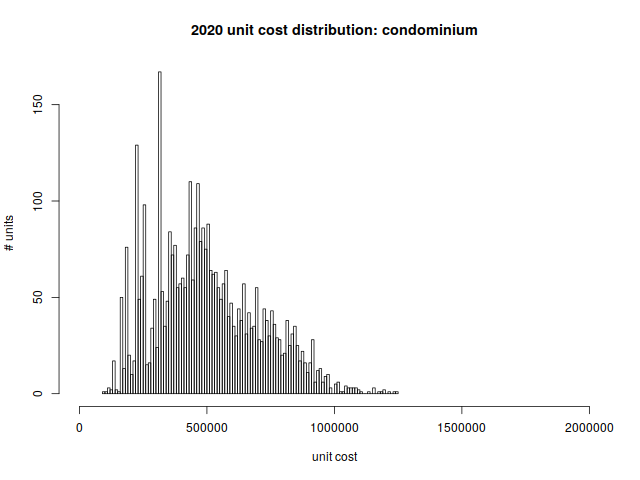
This graph is a histogram, as are the others in this article. The horizontal axis shows cost per unit, and the vertical axis shows the number of units in each particular cost band.
The per-unit price distribution is
| min | 1st quartile | median | mean | 3rd quartile | max |
| $92,600 | $344,450 | $473,100 | $500,086 | $640,850 | $1,241,000 |
Single-family homes
Single family homes are heavily concentrated around the $700,000 mark. There’s very little available for less than a half million dollars.
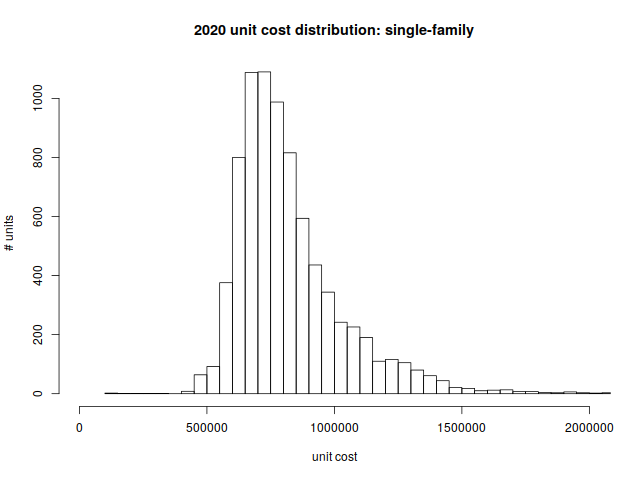
Per unit rice distribution:
| min | 1st quartile | median | mean | 3rd quartile | max |
| $103,700 | $679,900 | $771,900 | $825,172 | $908,750 | $3,232,700 |
The $103,700 single-family home deserves some explanation. The property straddles the border between Arlington and Lexington; it appears that the $103k assessed value reflects the portion that lies in Arlington.
Two-family Homes
Two-family homes are the bread and butter of East Arlington; they’re also common in the blocks off Mass ave near Brattle Square and the heights. Many of these homes are older and non-conforming, and they’re gradually being renovated and turned into condominiums.
As a reminder, these are costs per unit (as opposed to the cost of the entire two-family home).
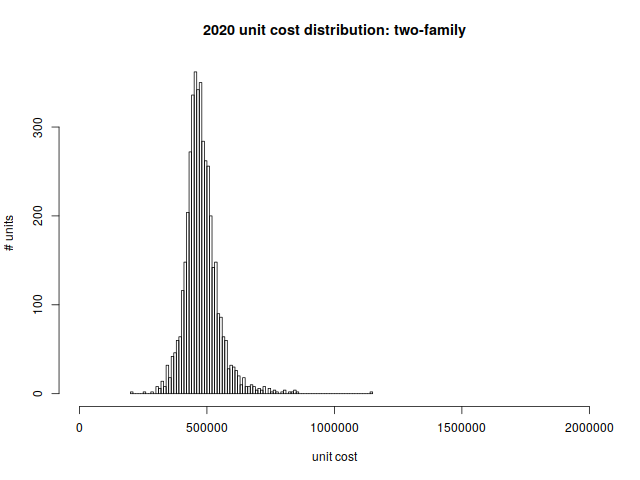
Per unit price distribution:
| Min | 1st quartile | median | mean | 3rd quartile | max |
| $209,050 | $440,550 | $472,000 | $479,175 | $508,588 | $1,140,450 |
Three-family Homes
Unlike Dorchester and Somerville, three-family homes are not a staple of Arlington’s housing stock. But we have a few of them. Most were built between 1906 and 1930.
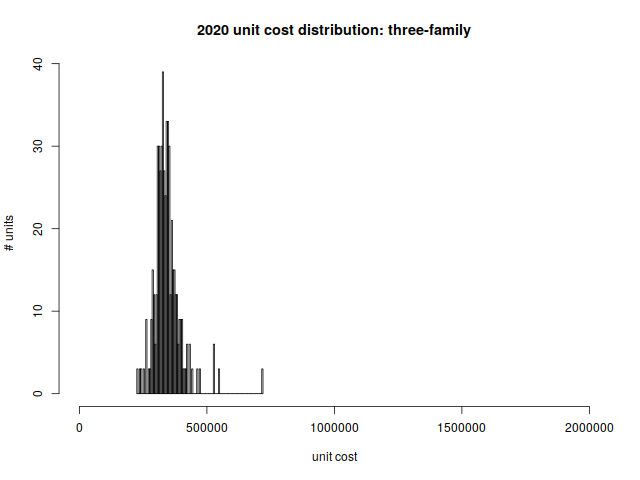
Per-unit price distribution:
| Min | 1st quartile | median | mean | 3rd quartile | max |
| $227,567 | $313,733 | $336,950 | $344,292 | $362,600 | $719,000 |
Small Apartments (4–8 units)
The majority of Arlington’s small apartment buildings were constructed during the first half of the 20th century. The most recent one dates from 1976.
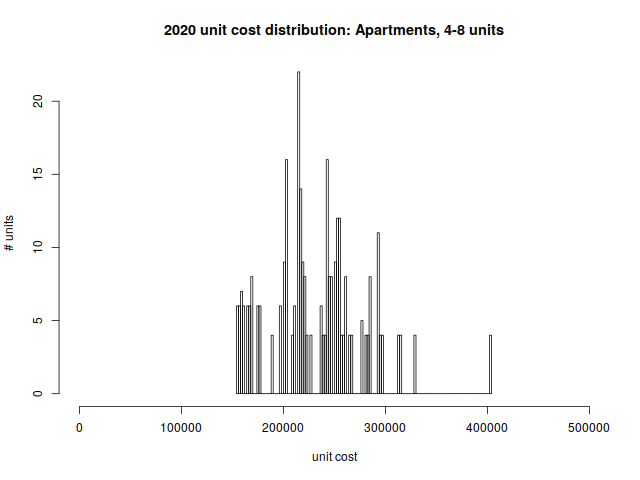
Per-unit price distribution:
| Min | 1st quartile | median | mean | 3rd quartile | max |
| $154,950 | $202,950 | $227,775 | $231,619 | $255,775 | $403,875 |
Large Apartments (9+ units)
You’ll see three outliers in the per unit-cost distribution for large apartment buildings. These correspond to the newest apartment complexes in Arlington: The Legacy (2000), Brigham Square (2012), and Arlington 360 (2013).
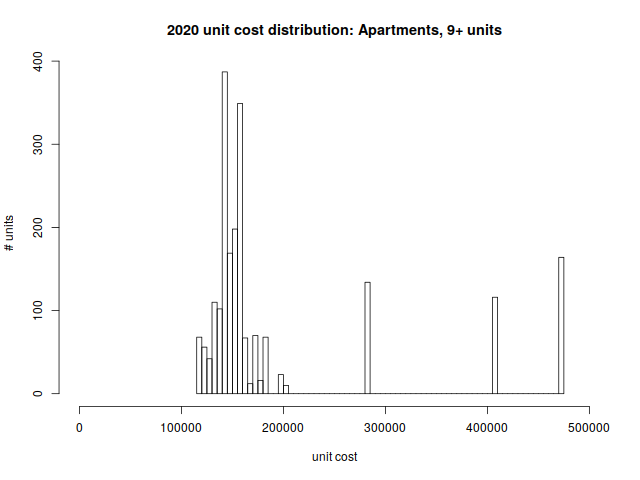
Per-unit price distribution:
| Min | 1st quartile | median | mean | 3rd quartile | max |
| $117,013 | $141,383 | $153,006 | $195,789 | $170,973 | $474,631 |
All combined
Finally, we’ll put it all together in one picture, representing nineteen-thousand and some odd homes in town.
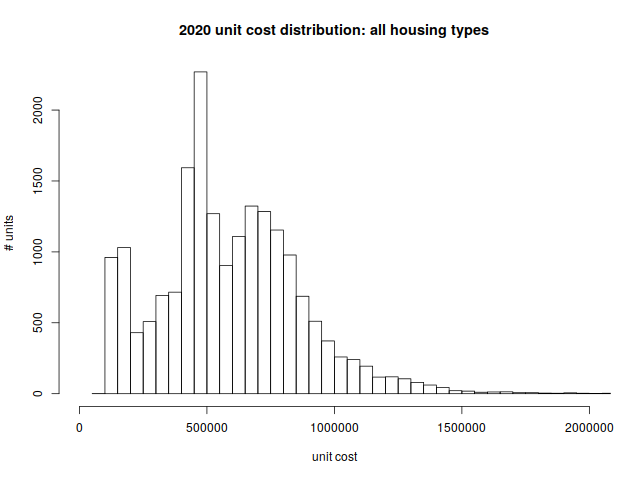
Per-unit price distribution:
| Min | 1st quartile | median | mean | 3rd quartile | max |
| $92,600 | $417,175 | $555,825 | $587,975 | $759,900 | $3,232,700 |
While there are lower-priced options available, a person coming to Arlington should expect to buy (or rent) a property that costs just shy of half a million dollars (or more).
Here is a spreadsheet with the cost distributions mentioned in this article.
by Steve Revilak
The term “AMI” or “Area Median Income” comes up in almost any discussion about affordable housing, because it’s used to set rents and the household incomes for people who are eligible to live in affordable dwellings. AMI is a fairly technocratic concept and my goal is to make the concept (and the numbers) easier to understand.
AMIs are set each year by the U.S. Department of Housing and Urban Development; broadly speaking, an AMI is the median income of a region. Arlington is part of the “Boston-Cambridge-Quincy, MA-NH HUD Metro FMR Area” which consists of more than 100 cities and towns in Massachusetts and New Hampshire. Median incomes represent the “middle” family income of an area—half of households make more, and half make less.
In the process of turning median incomes into income limits, HUD also considers household size: larger households are assigned larger AMI limits than smaller ones, in order to reflect the higher cost of living for more family members.
How do these limits translate into affordable housing regulations? Arlington’s affordable housing requirements (aka “inclusionary zoning”) require that rents for affordable units be priced for the 60% area median income, but the dwellings are available to households making up to 70%. Let’s show an example with some numbers.
| Household size | 60% Income Limit | 70% Income Limit | 60% Rent |
|---|---|---|---|
| 1 | $68,520 | $79,940 | $1,717/month |
| 2 | $78,360 | $91,420 | $1,959/month |
| 3 | $88,140 | $102,830 | $2,203/month |
HUD considers an apartment suitable for a household if it has one bedroom less than the number of household members, so a two-bedroom apartment would be suitable for a household of three, a one-bedroom would be suitable for a household of two, and a studio would be suitable for a household of one. The monthly rent for a two-bedroom apartment would be calculated as follows: $88,140 ÷ 12 × 30% = $2,203. The 30% comes from HUD’s rule that affordable housing tenants should not be cost-burdened, meaning that they pay no more than 30% of their income in rent.$88k or $102k/year can seem like a lot of money (and once upon a time it was). To get a better sense of what these income levels mean, I looked into what kinds of jobs pay these wages. To that end, I found wage information from the Arlington Public Schools report to Town Meeting, the Arlington town budget, and wage data from the Bureau of Labor Statistics. Here are a few scenarios:
Scenario 1: single adult
Scenario 1 represents a single adult living alone, and earning between $68,520 and $79,940. Jobs in this pay range include:
- Elementary classroom teacher ($62,000 – $75,000)
- Town planner ($75,000 – 79,000)
- Animal Control Officer ($72,000)
- Firefighter ($73,640)
- Librarian ($70,395)
- Lab Technician ($70,710)
- Social Worker ($71,470)
- Subway operator ($72,270)
- Licensed Practical Nurse ($75,690)
- Paralegal ($77,500)
- Chef ($78,040)
- Carpenter ($78,000)
Scenario 2: single parent with household of two
Scenario 2 represents a single parent earning between $78,360 and $91,420/year. Jobs in this pay range include:
- Office Manager – Assessor’s office ($80,399)
- Assistant Town Clerk ($77,375)
- Town Engineer ($74,000 – $80,000)
- Police Department Patrol Officer ($87,000)
- Town Budget Director ($88,488)
- Telecommunications equipment installer ($80,350)
- Plasterer and Stucco Mason ($82,250)
- Electrician ($82,380)
- Cement Mason ($86,250)
- Plumber and pipe fitter ($90,580)
Scenario 3: household of two, both adults
Scenario 3 has two adults, each earning $39,180 – $45,710 per year. Jobs in this salary range include several that we’ve come to know as “essential workers” during the pandemic.
- Special education teaching assistant ($34,290)
- Arlington Public Schools Paraprofessional ($36,290 – 42,440)
- Substitute Teacher ($34,921)
- Inspectional Services Record Keeper ($44,481)
- Food preparation worker ($39,590)
- Bartender ($39,730)
- Childcare worker ($40,470)
- Ambulance Driver ($40,890)
- Waiter ($41,440)
- Pharmacy aide ($41,460)
- Bank teller ($42,270)
- Tailor and dressmaker ($43,790)
- Restaurant cook ($44,140)
You may have noticed gaps in these lists — for example, there are no jobs listed in the $50,000 – $60,000 range because it’s in between the income limits for one- and two-income households. It’s also worth noting that a fair number of town employees’ salaries would qualify them for affordable housing (the town is Arlington’s largest employer).
So who qualifies to live in affordable housing? People with a lot of ordinary, working-class jobs, including many town employees.
The presentation, dated March 11, 2019, includes slides used to present the information necessary to understand the rationale for zoning changes, the location of the zoning areas under consideration and the charts, tables and maps that help describe the situation. The proposed zoning changes, especially articles 6, 7, 8, 11 and 16, only cover changes affecting about 7% of the Town, those parts of the Town that are currently zoned R4-R7 and the B zoning districts.
Article 1 in a series on the Arlington, MA master planning process. Prepared by Barbara Thornton
Arlington, located about 15 miles north west of Boston, is now developing a master plan that will reflect the visions and expectations of the community and will provide enabling steps for the community to move toward this vision over the next decade or two. Initial studies have been done, public meetings have been held. The Town will begin in January 2015 to pull together the vision for its future as written in a new Master Plan.
In developing a new master plan, the Town of Arlington follows in the footsteps laid down thousands of years ago when Greeks, Romans and other civilizations determined the best layout for a city before they started to build. In more recent times, William Penn laid out his utopian view of Philadelphia with a gridiron street pattern and public squares in 1682. Major Pierre Charles L’Enfant developed the hub and spoke street plan for Washington DC in 1798. City planning started with new cities, relatively empty land and a “master builder” typically an architect, engineer or landscape architect commissioned by the land holders to develop a visionary design.
In the 1900’s era of Progressive government in America, citizens sought ways to reach a consensus on how their existing cities should evolve. State and federal laws passed to help guide this process, seeing land use decisions as more than just a private landowner’s right but rather a process that involved improving the health and wellbeing of the entire community. While the focus on master planning was and still is primarily physical, 21st century master planners are typically convened by the local municipality, work with the help of trained planners and architects and rely heavily on the knowledge and participation of their citizenry to reflect a future vision of the health and wellbeing of the community. This vision is crafted into a Master Plan. In Arlington the process is guided by Carol Kowalski, Director of Planning and Community Development, with professional support from RKG Associates, a company of planners and architects and with the vision of the Master Planning advisory committee, co-chaired by Carol Svenson and Charles Kalauskas, Arlington residents, and by the citizens who share their concerns and hopes with the process as it evolves. This happens through public meetings, letters, email, and surveys. The most recent survey asks residents to respond on transportation modes and commuting patterns
We all do planning. Starting a family, a business or a career, we lay out our goals and assume the steps necessary to accomplish these goals and we periodically revise them as necessary. The same thing is true for cities. Based on changes in population, economic development, etc. cities, from time to time, need to revise their plans. In Massachusetts the enabling acts for planning and zoning are here http://www.mass.gov/hed/community/planning/zoning-resources.html. The specific law for Massachusetts is MGL Ch. 41 sect. 81D. This plan, whether called a city plan, master plan, general plan, comprehensive plan or development plan, has some constant characteristics independent of the specific municipality: focus on the built environment, long range view (10-20 years), covers the entire municipality, reflects the municipality’s vision of its future, and how this future is to be achieved. Typically it is broken out into a number of chapters or “elements” reflecting the situation as it is, the data showing the potential opportunities and concerns and recommendations for how to maximize the desired opportunities and minimize the concerns for each element.
Since beginning the master planning process in October, 2012, Arlington has had a number of community meetings (see http://vod.acmi.tv/category/government/arlingtons-master-plan/ ) gathering ideas from citizens, sharing data collected by planners and architects and moving toward a sense of what the future of Arlington should look like. The major elements of Arlington’s plan include these elements:
1. Visions and Goals http://www.arlingtonma.gov/home/showdocument?id=19829
2. Demographic Characteristics http://www.arlingtonma.gov/home/showdocument?id=19838
3. Land Use http://www.arlingtonma.gov/home/showdocument?id=19834
Working paper: http://www.arlingtonma.gov/home/showdocument?id=19825
4. Transportation http://www.arlingtonma.gov/home/showdocument?id=19830
Working paper: http://www.arlingtonma.gov/home/showdocument?id=19822
5. Economic Development http://www.arlingtonma.gov/home/showdocument?id=19837
Working paper: http://www.arlingtonma.gov/home/showdocument?id=19828
6. Housing http://www.arlingtonma.gov/home/showdocument?id=19835
Working paper: http://www.arlingtonma.gov/home/showdocument?id=19826
7. Open Space and Recreation http://www.arlingtonma.gov/home/showdocument?id=19832
Working paper: http://www.arlingtonma.gov/home/showdocument?id=19824
8. Historic and Cultural Resources http://www.arlingtonma.gov/home/showdocument?id=19836
Working paper: http://www.arlingtonma.gov/home/showdocument?id=19827
9. Public Facilities and Services http://www.arlingtonma.gov/home/showdocument?id=19831
Working paper: http://www.arlingtonma.gov/home/showdocument?id=19823
10. Natural Resources
Working paper: http://www.arlingtonma.gov/home/showdocument?id=19824
The upcoming articles in this series will focus on each individual element in the Town of Arlington’s Master Plan.
Data in a Mass Housing Partnership report shows how far behind the Boston metropolitan area has fallen in meeting the housing needs of its citizens. There are four primary categories for measuring the inadequacies: 1. Availability, 2. Affordability, 3. L0cation and Mobility and 4. Equitability. See the full report for more data and examples. Two slides are shown below.
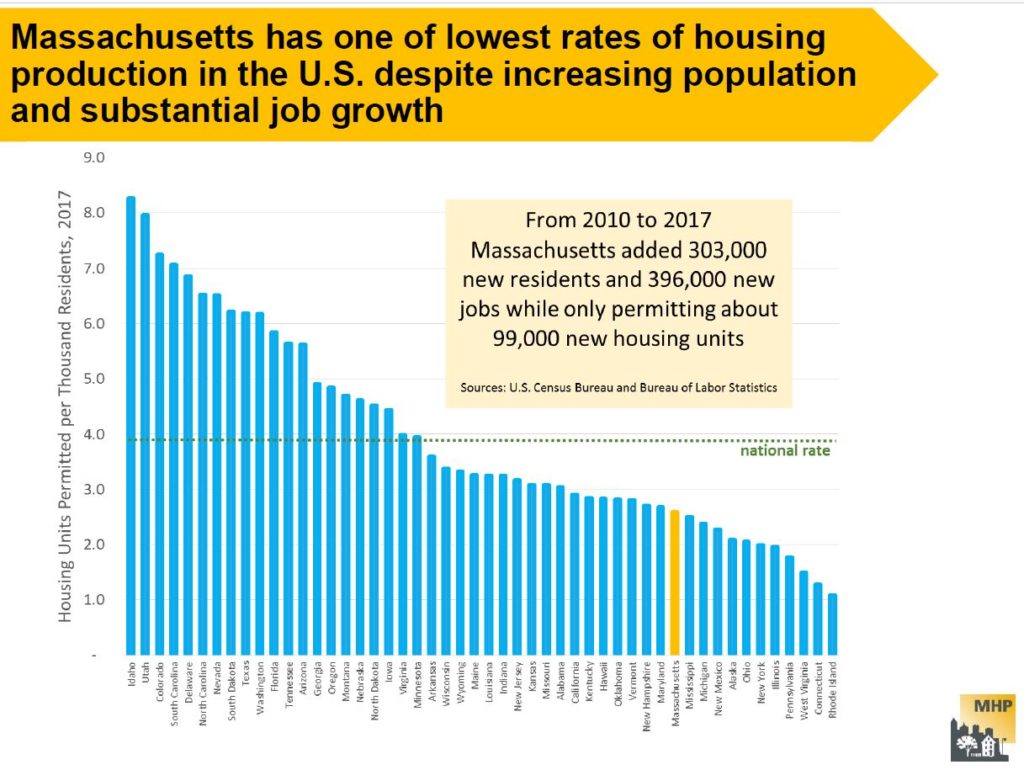
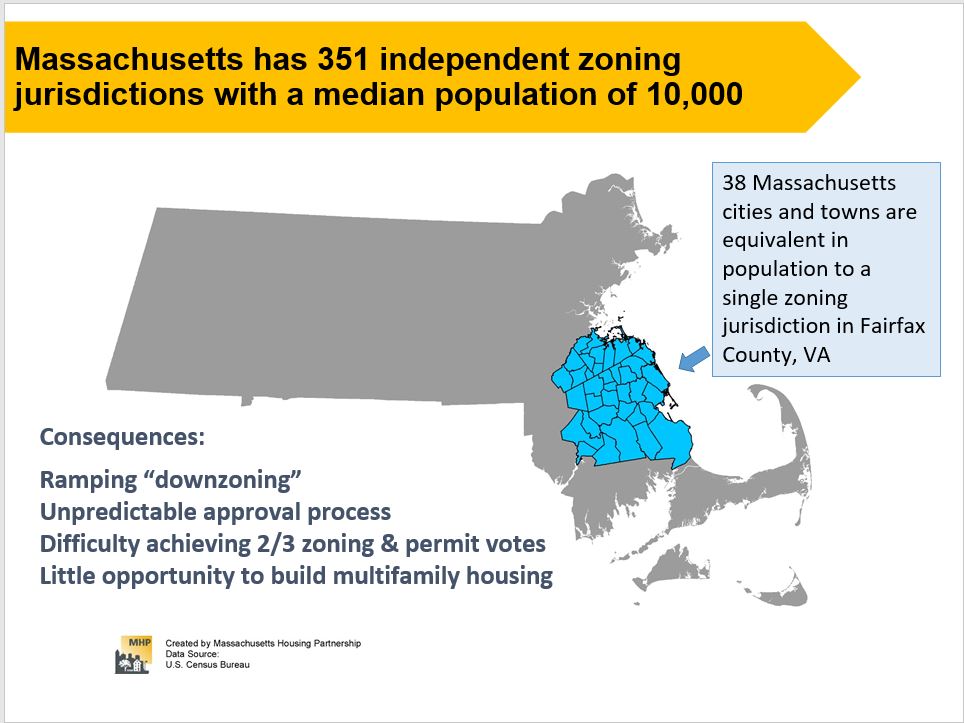
(This post was originally an email message, discussion open space changes proposed by an Affordable Housing article during the Arlington, MA’s 2019 town meeting. It’s also a decent description of our town’s open space laws.)
Sorry this turned out to be a long post. Our open space laws are kind of complicated.
Arlington regulates open space as a percentage of gross floor area, rather than as a percentage of lot area. Let me give a concrete example: say we have a-one story structure with no basement. It covers a certain percentage of the lot area, and has an open space requirement based on the gross floor area (i.e., the interior square footage of the building).
Now, suppose we want to turn this into a two- or three-story structure. The building footprint does not change, and it covers exactly the same percentage of the lot area. However, the open space requirements double (if you’re doing a two-story building), or triple (if you’re doing a three story building). If that quantity of open space isn’t on the lot, then you can’t add the stories.
For this reason, I’d argue that our open space regulations are primarily oriented to limiting the size of buildings. You really can’t allow more density (or taller buildings) without reducing the open space requirements. Alternatively, if the requirements were based on a percentage of lot area, we probably wouldn’t need a reduction. (Cambridge’s equivalent is “Private Open Space”, and they regulate it as a percentage of lot area.)
The other weird thing about our open space laws is that we define “usable open space” in such a way that it’s possible to have none. (Usable open space must have a minimum horizontal dimension of 25′, a grade of 8% or less, and be free of parking and vehicular traffic). I live on a nonconforming lot that does not meet these requirements, as do the majority of homes in my neighborhood.
Suppose I wanted to build an addition, which would increase the gross floor area. With the non-conformity, I’d have to go in front of the ZBA and show that the current lot has 0% usable open space, and that the house + addition produces a lot with 0% usable open space. Because 0% = 0%, I have not increased the nonconformity, and would be able to build the addition, provided that all of the other dimensional constraints of the bylaw are satisified. Although this isn’t directly related to Article 16, it’s an amusing side effect of how the bylaw is written.
Finally, roofs and balconies. Section 5.3.19 of our current ZBL allows usable open space on balconies at least six feet wide, and on roofs that are no more than 10′ above the lowest occupied floor. We allow 50% of usable open space requirements to be satisfied in this manner.
The relevant section of Article 16 would create a 8.2.4(C)(1) which includes the language
Up to 25% of the landscaped open space may include balconies at least 5 feet by 8 feet in size only accessible through a dwelling unit and developed for the use of the occupant of such dwelling unit.
Article 16’s incentive bonuses strike the usable open space requirement, and double the landscaped open space requirement. With only landscaped open space, 5.3.19 doesn’t apply (it only pertains to usable open space). The language I’ve quoted adds something 5.3.19-like, but for landscaped open space. I say 5.3.19-like because it has a 25% cap rather than a 50% cap, and requires eligible balconies to be at least 5’x8′, rather than 6′ wide.
Here are a few pieces of supporting documentation:
- definitions of landscaped and usable open space from our ZBL
- a diagram to illustrate the difference between landscaped and usable open space.
- The text of section 5.3.19 (which is referenced by the diagram)
- the main motion for Article 16
It’s January 2023, and as we do every year, folks in Arlington are taking out nomination papers, gathering signatures, and strategizing on how to campaign for the town election on Saturday April 1st. The town election is where we choose members of Arlington’s governing institutions, including the Select Board (Arlington’s executive branch), the School Committee, and — most relevantly for this post — Town Meeting.
If you’re new to New England, Town Meeting is an institution you may not have heard of, but it’s basically the town’s Legislative Branch. Town Meeting consists of 12 members from each of 21 Precincts, for 252 members total. Members serve three-year terms, with one-third of the seats up for election in any year, so that each precinct elects four representatives per year (perhaps with an extra seat or two, as needed to fill vacancies). For a deeper dive, Envision Arlington’s ABC’s of Arlington Government gives a great overview of Arlington’s government structure.
As our legislative branch, town meeting’s powers and responsibilities include:
- Passing the Town’s Operating Budget, which details planned expenses for the next year.
- Approving the town’s Capital Budget, which includes vehicle and equipment purchases, playgrounds, and town facilities.
- Bylaw changes. Town meeting is the only body that can amend the towns bylaws, including ones that affect housing and commercial development.
Town Meeting is an excellent opportunity to serve your community, and to learn about how Arlington and its municipal government works. Any registered voter is eligible to run. If this sounds like an interesting prospect, I’d encourage you to run as a candidate. Here’s what you’ll need to do:
- Have a look at the town’s Information for new and Prospective Town Meeting Members.
- Contact the Town Clerk’s office to get a set of nomination papers. You’ll need to do this by 5:00 PM February 8th, 2023 at the latest.
- Gather signatures. You’ll need signatures from at least ten registered voters in your precinct to get on the ballot (it’s always good to get a few extra signatures, to be safe).
- Return your signed nomination papers to the Clerk’s office by February 10, 2023 at noon.
- Campaign! Get a map and voter list for your precinct, knock on doors, and introduce yourself. (Having a flier to distribute is also helpful.)
- Vote on Saturday April 1st, and wait for the results.
Town Meeting traditionally meets every Monday and Wednesday, from 8:00 — 11:00 pm, starting on the 4th Monday in April (which is April 24th this year), and lasting until the year’s business is concluded (typically a few weeks).
If you’d like to connect with an experienced Town Meeting Member about the logistics of campaigning, or the reality of serving at Town Meeting, please email info(AT)equitable-arlington.org and I’d be happy to make an introduction.
During the past few years, Town Meeting was our pathway to legalizing accessory dwelling units, reducing minimum parking requirements, and loosening restrictions on mixed-use development in Arlington’s business districts. Aside from being a rewarding experience, it’s a way to make a difference!